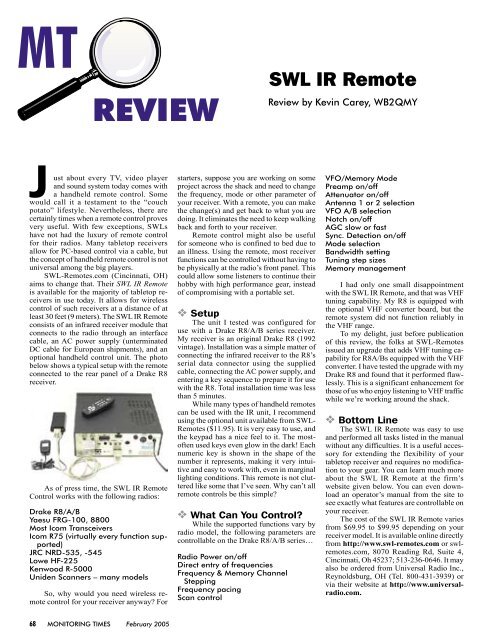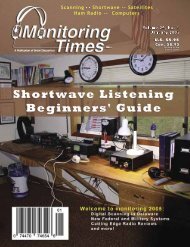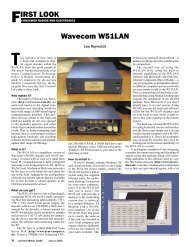SWL IR Remote - Monitoring Times
SWL IR Remote - Monitoring Times
SWL IR Remote - Monitoring Times
Create successful ePaper yourself
Turn your PDF publications into a flip-book with our unique Google optimized e-Paper software.
MT<br />
REVIEW<br />
<strong>SWL</strong> <strong>IR</strong> <strong>Remote</strong><br />
Review by Kevin Carey, WB2QMY<br />
Just about every TV, video player<br />
and sound system today comes with<br />
a handheld remote control. Some<br />
would call it a testament to the “couch<br />
potato” lifestyle. Nevertheless, there are<br />
certainly times when a remote control proves<br />
very useful. With few exceptions, <strong>SWL</strong>s<br />
have not had the luxury of remote control<br />
for their radios. Many tabletop receivers<br />
allow for PC-based control via a cable, but<br />
the concept of handheld remote control is not<br />
universal among the big players.<br />
<strong>SWL</strong>-<strong>Remote</strong>s.com (Cincinnati, OH)<br />
aims to change that. Their <strong>SWL</strong> <strong>IR</strong> <strong>Remote</strong><br />
is available for the majority of tabletop receivers<br />
in use today. It allows for wireless<br />
control of such receivers at a distance of at<br />
least 30 feet (9 meters). The <strong>SWL</strong> <strong>IR</strong> <strong>Remote</strong><br />
consists of an infrared receiver module that<br />
connects to the radio through an interface<br />
cable, an AC power supply (unterminated<br />
DC cable for European shipments), and an<br />
optional handheld control unit. The photo<br />
below shows a typical setup with the remote<br />
connected to the rear panel of a Drake R8<br />
receiver.<br />
As of press time, the <strong>SWL</strong> <strong>IR</strong> <strong>Remote</strong><br />
Control works with the following radios:<br />
Drake R8/A/B<br />
Yaesu FRG-100, 8800<br />
Most Icom Transceivers<br />
Icom R75 (virtually every function supported)<br />
JRC NRD-535, -545<br />
Lowe HF-225<br />
Kenwood R-5000<br />
Uniden Scanners – many models<br />
So, why would you need wireless remote<br />
control for your receiver anyway? For<br />
starters, suppose you are working on some<br />
project across the shack and need to change<br />
the frequency, mode or other parameter of<br />
your receiver. With a remote, you can make<br />
the change(s) and get back to what you are<br />
doing. It eliminates the need to keep walking<br />
back and forth to your receiver.<br />
<strong>Remote</strong> control might also be useful<br />
for someone who is confined to bed due to<br />
an illness. Using the remote, most receiver<br />
functions can be controlled without having to<br />
be physically at the radio’s front panel. This<br />
could allow some listeners to continue their<br />
hobby with high performance gear, instead<br />
of compromising with a portable set.<br />
❖ Setup<br />
The unit I tested was configured for<br />
use with a Drake R8/A/B series receiver.<br />
My receiver is an original Drake R8 (1992<br />
vintage). Installation was a simple matter of<br />
connecting the infrared receiver to the R8’s<br />
serial data connector using the supplied<br />
cable, connecting the AC power supply, and<br />
entering a key sequence to prepare it for use<br />
with the R8. Total installation time was less<br />
than 5 minutes.<br />
While many types of handheld remotes<br />
can be used with the <strong>IR</strong> unit, I recommend<br />
using the optional unit available from <strong>SWL</strong>-<br />
<strong>Remote</strong>s ($11.95). It is very easy to use, and<br />
the keypad has a nice feel to it. The mostoften<br />
used keys even glow in the dark! Each<br />
numeric key is shown in the shape of the<br />
number it represents, making it very intuitive<br />
and easy to work with, even in marginal<br />
lighting conditions. This remote is not cluttered<br />
like some that I’ve seen. Why can’t all<br />
remote controls be this simple?<br />
❖ What Can You Control?<br />
While the supported functions vary by<br />
radio model, the following parameters are<br />
controllable on the Drake R8/A/B series…<br />
Radio Power on/off<br />
Direct entry of frequencies<br />
Frequency & Memory Channel<br />
Stepping<br />
Frequency pacing<br />
Scan control<br />
VFO/Memory Mode<br />
Preamp on/off<br />
Attenuator on/off<br />
Antenna 1 or 2 selection<br />
VFO A/B selection<br />
Notch on/off<br />
AGC slow or fast<br />
Sync. Detection on/off<br />
Mode selection<br />
Bandwidth setting<br />
Tuning step sizes<br />
Memory management<br />
I had only one small disappointment<br />
with the <strong>SWL</strong> <strong>IR</strong> <strong>Remote</strong>, and that was VHF<br />
tuning capability. My R8 is equipped with<br />
the optional VHF converter board, but the<br />
remote system did not function reliably in<br />
the VHF range.<br />
To my delight, just before publication<br />
of this review, the folks at <strong>SWL</strong>-<strong>Remote</strong>s<br />
issued an upgrade that adds VHF tuning capability<br />
for R8A/Bs equipped with the VHF<br />
converter. I have tested the upgrade with my<br />
Drake R8 and found that it performed flawlessly.<br />
This is a significant enhancement for<br />
those of us who enjoy listening to VHF traffic<br />
while we’re working around the shack.<br />
❖ Bottom Line<br />
The <strong>SWL</strong> <strong>IR</strong> <strong>Remote</strong> was easy to use<br />
and performed all tasks listed in the manual<br />
without any difficulties. It is a useful accessory<br />
for extending the flexibility of your<br />
tabletop receiver and requires no modification<br />
to your gear. You can learn much more<br />
about the <strong>SWL</strong> <strong>IR</strong> <strong>Remote</strong> at the firm’s<br />
website given below. You can even download<br />
an operator’s manual from the site to<br />
see exactly what features are controllable on<br />
your receiver.<br />
The cost of the <strong>SWL</strong> <strong>IR</strong> <strong>Remote</strong> varies<br />
from $69.95 to $99.95 depending on your<br />
receiver model. It is available online directly<br />
from http://www.swl-remotes.com or swlremotes.com,<br />
8070 Reading Rd, Suite 4,<br />
Cincinnati, Oh 45237; 513-236-0646. It may<br />
also be ordered from Universal Radio Inc.,<br />
Reynoldsburg, OH (Tel. 800-431-3939) or<br />
via their website at http://www.universalradio.com.<br />
68 MONITORING TIMES February 2005
H-900 Gainprobe from LF Engineering<br />
By Bob Grove W8JHD<br />
W<br />
hen an outdoor dipole or random<br />
wire for shortwave reception<br />
is not practical or desirable,<br />
a two-foot vertical sounds like a pretty<br />
good alternative!<br />
For many years, LF Engineering has led<br />
the field of affordable active antennas; their<br />
H800 Skymatch offers excellent performance<br />
over the wide frequency range of 10 kHz-50<br />
MHz. Now, LF Engineering has introduced<br />
a new model, the H900.<br />
With better high-frequency performance<br />
and extending the upper frequency to 60 MHz<br />
(-3 dB), the H-900 will make many shortwave<br />
listeners have second thoughts about erecting<br />
wire antennas. This new active antenna can<br />
be mounted in a variety of locations, outdoor<br />
or in – like its predecessor, it’s only 25 inches<br />
long, and a mere inch in diameter.<br />
The added features in the new model<br />
include an improved MOS-FET amplifier in<br />
the probe, and the introduction of a high performance<br />
signal amplifier within the coupler.<br />
There is no internal battery option available<br />
for the H-900, because the current drain of<br />
the new design, up to 80 mA with the signal<br />
amplifier on, would rapidly discharge an internal<br />
battery. An AC wall adaptor is included<br />
to provide the necessary 12 VDC power.<br />
But if battery operation is still desired<br />
to isolate the antenna system from AC line<br />
interference, an external 12 volt battery can<br />
be readily attached through the mini-jack used<br />
for the AC adaptor.<br />
The low-noise preamplifier offers 6-12<br />
dB higher gain than the former model as well,<br />
and is integrated into the hermetically-sealed<br />
antenna assembly (tested to -66 ft. pressure,<br />
or two atmospheres). The remote-mountable<br />
antenna assembly is connected to the control<br />
box (measures approx. 4” x 2-1/2” x 1-1/2”)<br />
by 50 feet of thin-diameter RG-174/U coax.<br />
The control box also contains a toggle switch<br />
that can be used to kick in an additional 10 dB<br />
of wideband gain for the weakest signals.<br />
Purists may be suspicious of signal loss<br />
in RG-174/U, but at these design frequencies<br />
and length of line, that’s not really an<br />
issue. Not only that, but the power output<br />
of the preamp is a husky 16 dBm, enough to<br />
overcome any loss in the line! The directions<br />
say that the coax can actually be extended by<br />
an additional length of up to 200 feet with no<br />
appreciable loss of signal!<br />
To overcome third-order intermodulation,<br />
the bane of preamplified antenna systems,<br />
the husky amplifier in the H-900 boasts<br />
an IP3 greater than 35 dBm.<br />
The antenna system operates over a wide<br />
temperature range of -25 to +120 degrees<br />
Fahrenheit, adequate for just about any geographical<br />
application.<br />
While we would have preferred SO-239<br />
coax connectors, the RCA phono jacks used<br />
on the H900 are easily adapted to the fitting<br />
required for any receiver.<br />
Since no adjustments are required, this<br />
product is about as close to “plug and play” as<br />
you can get. Just be sure to plug the antenna<br />
input and output cables into the right receptacles!<br />
❖ So how well does it work?<br />
Comparing the H-900 with a 50-foot wire<br />
antenna at approximately the same elevation,<br />
reception was virtually identical throughout<br />
the 100 kHz-30 MHz spectrum. In the AM<br />
broadcast band (530-1700 kHz), there was<br />
no evidence of intermodulation from our local<br />
broadcasters in spite of their S9 +30 dB<br />
signal levels.<br />
Equally important was the absence of<br />
amplifier-generated “hiss” which obscures<br />
weak signals and artificially deflects the S-<br />
meter higher. Off-signal, our S-meter stayed<br />
right on 0 with the preamplifier turned on or<br />
off.<br />
For two-way radio users, saturation from<br />
a nearby transmitting antenna is a real concern<br />
with active antennas. In our experiment, an<br />
adjacent antenna for a 60-watt, two-meter<br />
transceiver caused no HF desensitization of<br />
the H-900.<br />
Keeping in mind that the H-900 sensitivity<br />
rolls off above 60 MHz, we couldn’t<br />
resist the temptation to try it on a VHF/UHF<br />
scanner. At 160 MHz and 460 MHz, signals<br />
were down by more than 20 dB, and at 860<br />
MHz they were down by a good 30 dB. That<br />
was to be expected.<br />
While it would be nice to have an active<br />
antenna that works with the new breed<br />
of wide-frequency-coverage receivers that<br />
have only one antenna port, the new H-900<br />
GainProbe is a welcome addition to the below-30<br />
MHz shortwave, medium wave, and<br />
longwave receiving market. Its performance<br />
is equivalent to a much larger wire antenna,<br />
and its compact, weatherproof construction<br />
invites installation just about anywhere.<br />
The H900 GainProbe ($189) and the<br />
standard H800 SkyMatch ($139) are available<br />
exclusively from Grove Enterprises (1-800-<br />
438-8155; 7540 Hwy 64 West, Brasstown,<br />
NC 28904; http://www.grove-ent.com)<br />
<strong>IR</strong> REMOTE RADIO CONTROL<br />
<strong>Remote</strong> control your Shortwave Receiver, Scanner,<br />
or ICOM Transceiver from your easy chair with the<br />
<strong>SWL</strong> <strong>IR</strong> <strong>Remote</strong> and a Universal TV <strong>Remote</strong> control.<br />
<strong>SWL</strong> <strong>IR</strong> <strong>Remote</strong> for Drake R8/A/B . . . . . . . $89.95<br />
<strong>SWL</strong> <strong>IR</strong> <strong>Remote</strong> for Yaesu FRG-100 . . . . . .$79.95<br />
<strong>SWL</strong> <strong>IR</strong> <strong>Remote</strong> for Yaesu FRG-8800 . . . . $79.95<br />
<strong>SWL</strong> <strong>IR</strong> <strong>Remote</strong> for ICOM Transceiver . . . $69.95<br />
<strong>SWL</strong> <strong>IR</strong> <strong>Remote</strong> for ICOM IC-R75. . . . . . . . $79.95<br />
<strong>SWL</strong> <strong>IR</strong> <strong>Remote</strong> for JRC NRD-535, NRD-545. $89.95<br />
<strong>SWL</strong> <strong>IR</strong> <strong>Remote</strong> for Lowe HF-150, HF-225. $79.95<br />
<strong>SWL</strong> <strong>IR</strong> <strong>Remote</strong> for Kenwood R-5000 . . . . $79.95<br />
<strong>SWL</strong> <strong>IR</strong> <strong>Remote</strong> for Uniden Scanners . . . . $89.95<br />
www.swl-remotes.com<br />
February 2005 MONITORING TIMES 69

















